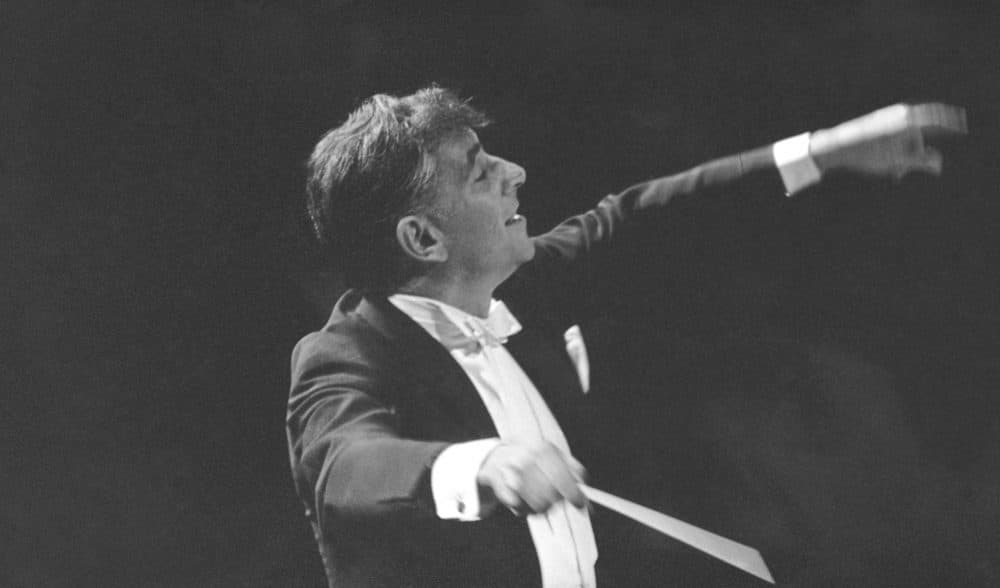Advertisement
Listening To Bernstein's 'Age Of Anxiety' In Anxious Times

Classical music columnist Fran Hoepfner (@franhoepfner) joins Here & Now's Lisa Mullins to discuss Leonard Bernstein's second symphony, "The Age of Anxiety," which he wrote in the years following World War II when he was 30 years old.
"He based it on and W.H. Auden poem of the same title, and that poem I think was extremely sort of reflective of modern anxieties, of just young people living in cities," Hoepfner says. "And Bernstein's friends sent him the poem and ... wrote him something along the lines of, 'I think you could do something really interesting with this piece of writing and translating it into music.' "
Interview Highlights
On what was happening in the world when Bernstein wrote the piece
"Well, I think you see a lot of general confusion and disillusionment in the years following the Second World War, and no doubt that also played into a big part of Bernstein's life, as he was trying to navigate his own career. He moved a lot between conducting and composing, and maybe is perhaps best known for his film scores now, but was also trying to work within maybe a little bit more of a classical composer career narrative for a bit."
On the unusual concept behind the symphony: four strangers who meet in a bar in wartime New York City
"I think he sort of waffled between making it a ballet, or an opera — there was so much that could be done with this general idea of four characters, and yet it comes together as this six-movement symphonic composition."
On the piece's second movement, "The Life of Man"
"I like the playfulness of this little section here. I think it broadly shows a more optimistic view of childhood that quickly descends, I think, into a little bit of, like, angst and anxiety with teenage years. And I just love the way in which this move in particular fluctuates."
On the third movement, "The Seven Stages"
"I think the piano plays a really interesting role in this, in that the piece is for orchestra and solo piano — it's not a piano concerto by any means, so it almost puts the piano and the orchestra on equal footing. They're constantly in dialogue with each other.
"I think the balance and the constant back and forth between the piano and the orchestra, I see the piano as kind of the protagonist, and maybe the orchestra is the city, and the times, if you will, and having those constantly be in dialogue and never letting one get too far away from the other is what keeps a very tense balance between them."
"I like that it's a piece that's sort of constantly in transit — it's moving not only through time, but also through setting."
Fran Hoepfner
On the fourth movement, "The Dirge," featuring solo piano
"I think the most stressful movement in this to listen to. There's something that puts me truly on edge, just listening to this. I think it really creates a great sense of suspense about what comes next, and the percussion really comes to life in this movement."
On what makes the piece relevant today
"I like that it's a piece that's sort of constantly in transit — it's moving not only through time, but also through setting. And I don't think you have to know that it's based on a poem in order to appreciate the way in which it kind of carries you through a more abstract and confusing narrative. I think the emotions are really present and front-facing about the piece, and kind of just knowing the title, 'Age of Anxiety,' brings it all to a head. And I also think it's a really, just powerful work, about youth, and the unknown and this really tenuous balance between suspense and anger and some real, profound joy.
"I like that [Bernstein] just always carried it with him. ... And I think it's reflective of something that ... like an idea that sticks, that no matter where you are, is kind of with you."
On why the piece has made such an impact
"I think what's great about this piece is it definitely has a lot of those very, what we now know as classic Bernstein refrains, that do become hummable and memorable. But the broad darkness of the piece, and how it feels kind of unknowable, and how it ends on such an uncertain note, I think allows it to kind of transcend into something that sticks with you a little more. It is a little bit of a disturbing piece of music, without being, you know, ugly or anything like that."
More Music From The Segment
"Prologue," from "Symphonic Dances From West Side Story," Columbia 1961 recording, with composer Leonard Bernstein conducting the New York Philharmonic
"Cool Fugue (Allegretto)," from "Symphonic Dances From West Side Story," Columbia 1961 recording, with composer Leonard Bernstein conducting the New York Philharmonic
"Somewhere," from "Symphonic Dances From West Side Story," Columbia 1961 recording, with composer Leonard Bernstein conducting the New York Philharmonic
This article was originally published on April 16, 2018.
This segment aired on April 16, 2018.




